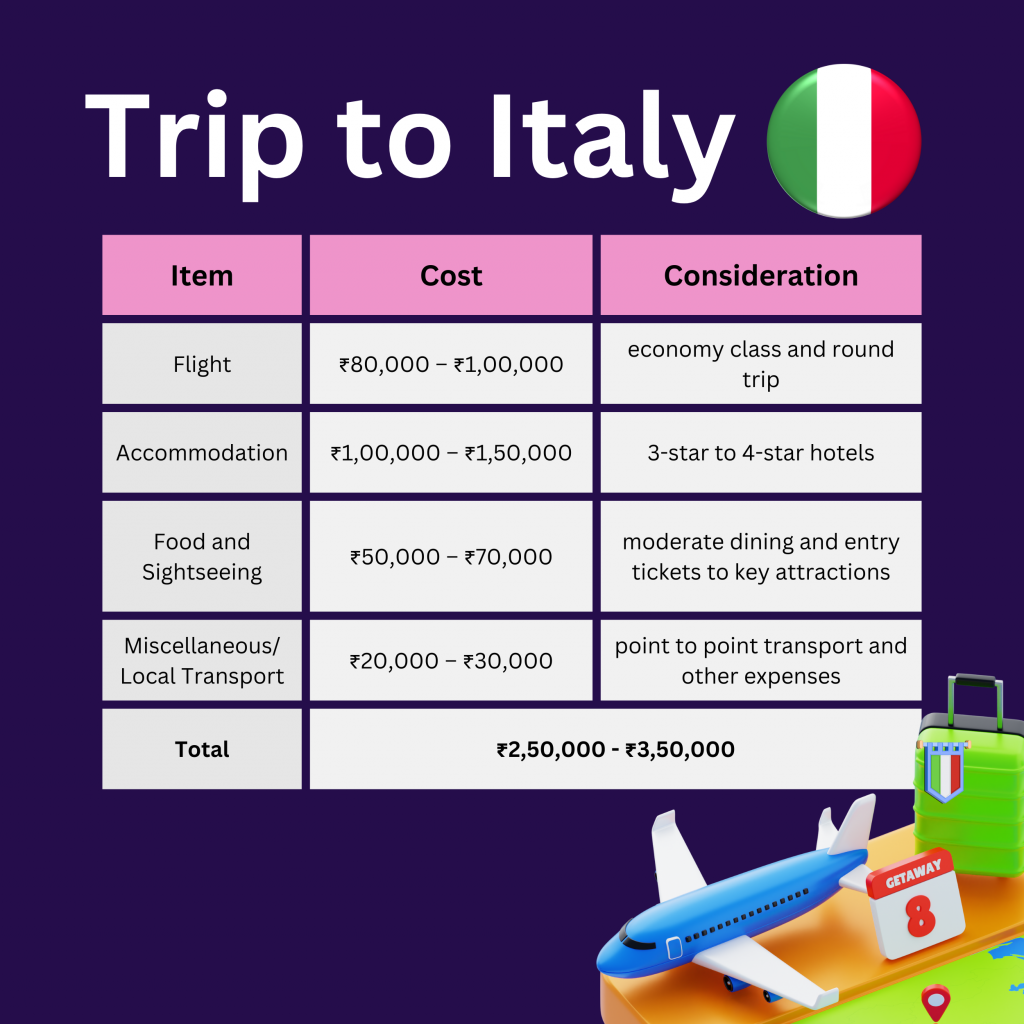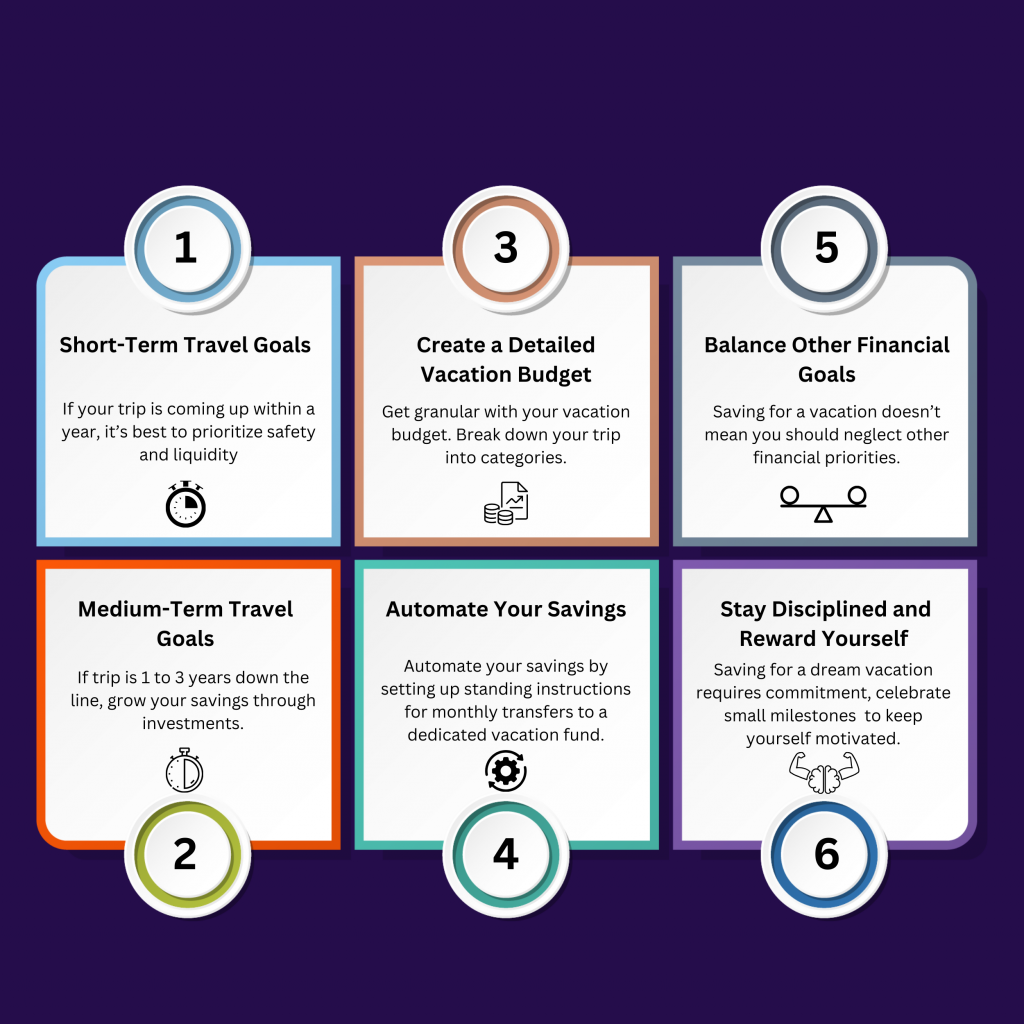
Key Takeaways for Vacation Planning
- Start Early: The earlier you start saving, the less pressure you’ll feel. A 12–18-month plan spreads the cost and allows you to grow your savings through smart investments, making destinations like Thailand, Bali, or Paris more attainable.
- Create a Dedicated Fund: Set up a separate account or investment for your vacation savings to avoid mixing it with other financial goals.
- Choose the Right Investment: For trips within 1–3 years, prioritize low-risk, short-term options like liquid funds or recurring deposits.
- Automate Your Savings: Set up standing instructions to transfer funds monthly into your vacation account to ensure consistency.
- Budget Smartly: Break down trip costs (flights, accommodation, food, activities) and track your progress to stay on target.
- Stay Financially Balanced: Never compromise on essential savings, emergency funds, or long-term goals for a vacation.
- Enjoy the Journey: Celebrate small savings milestones and stay motivated to make your dream vacation a reality.
By following these steps, you can enjoy a well-planned, stress-free trip in 2025 while keeping your finances in check.
Imagine sipping coffee at a quaint Parisian café, trekking through the breathtaking trails of New Zealand, or soaking in the sun at a luxury Maldives resort, exploring the vibrant streets of Bangkok, relaxing on the serene beaches of Bali, or strolling through the romantic avenues of Paris.
Your dream vacation is no longer just a Pinterest board; it’s a goal waiting to be achieved! But to turn those dreamy snapshots into reality, you need more than just wanderlust—you need a solid financial plan.
In this blog, we’ll guide you through the art of saving and investing for your dream vacation in 2025. Whether it’s a solo adventure or a family getaway, Cashvisory can help you create a step-by-step roadmap to turn your travel dreams into achievable financial goals.
Step 1: Understanding the Dream Vacation Fund
Let’s start with a simple truth: saving for travel doesn’t have to feel overwhelming. Think of it as building a dedicated vacation fund—a stash of money you set aside just for that one goal.
Why Have a Vacation Fund?
- Clarity and Focus: A separate fund ensures you don’t mix travel savings with other expenses.
- Motivation: Watching your savings grow gets you closer to that dream beach or bustling city.
- Better Financial Health: No need to drain your savings or rely on credit cards last minute.
Set a Realistic Target
For example, let’s say you’re planning a 10-day trip to Italy in 2025. You estimate costs:
Your estimate of ₹2.5 lakh for a 10-day trip to Italy might be on the conservative side for an international vacation of that scale. Here’s a breakdown based on typical costs for such a trip in INR:

Flights: ₹80,000 – ₹1,00,000 (economy class, round trip).
- Accommodation: ₹1,00,000 – ₹1,50,000 (3-star to 4-star hotels).
- Food and Sightseeing: ₹50,000 – ₹70,000 (moderate dining and entry tickets to key attractions).
- Miscellaneous/Local Transport: ₹20,000 – ₹30,000.
Revised Total Budget: ₹2.5 lahks may be achievable if you’re budgeting strictly, but ₹3 lahks to ₹3.5 lakhs might be more realistic for a comfortable trip.
With this in mind, you now have a clear financial target. Break it down: if you started in January 2024, you’ll need to save approximately ₹12,500 monthly for the next 20 months. Doesn’t seem so intimidating, right?
Step 2: Smart Investment Strategies for Vacation Goals

1. Short-Term Travel Goals (Less than 1 Year):
If your trip is coming up within a year, it’s best to prioritize safety and liquidity. Consider:
- Savings accounts: Keep your funds accessible for easy withdrawals.
- Recurring deposits (RDs): Earn slightly better returns than regular savings accounts while maintaining low risk.
2. Medium-Term Travel Goals (1–3 Years):
For trips planned in 1 to 3 years down the line, you have the option to grow your savings through investments. Consider:
- Liquid Funds: These mutual funds offer low risk and better returns (~5–6%) than traditional savings options.
- Short-Term Debt Funds: Suitable for stability and returns, debt funds are a good option if you’re saving for 1–2 years.
Real-Life Example:
Akshay, a 30-year-old IT professional, planned a ₹2 lakh trip to Bali for 2025. He invested ₹8,500 monthly in a liquid mutual fund offering ~5% returns. In two years, his savings grew to ₹2.1 lakh, covering his travel costs comfortably.
Step 3: Create a Detailed Vacation Budget
Once you’ve set your savings strategy, it’s time to get granular with your vacation budget. Break down your trip into categories:
- Flights and Accommodation: These are typically the largest expenses. Book flights and hotels well in advance to lock in lower rates.
- Food and Activities: Research local options to estimate daily costs. Avoid overspending on tourist traps by exploring budget-friendly alternatives.
- Currency Exchange: For international trips, monitor exchange rates and consider preloading forex cards to save on conversion charges.
Pro Tip: Use travel planning tools or apps to track your budget and avoid last-minute financial surprises.
Step 4: Automate Your Savings
Consistency is key when saving for a big trip. Automate your savings by setting up standing instructions for monthly transfers to a dedicated vacation fund. This removes the temptation to spend the money elsewhere and ensures you stay on track.
Real-Life Example:
Megha, a 27-year-old marketing executive, used a recurring deposit to save ₹12,000 monthly for her Europe trip in 2025. She automated her savings and didn’t miss a single month. By December 2025, she had accumulated enough to enjoy a stress-free vacation without relying on loans or credit cards.
Step 5: Balance Other Financial Goals
Saving for a vacation doesn’t mean you should neglect other financial priorities. Make sure you:
- Have an emergency fund in place.
- Continue contributing to long-term goals like retirement or a house.
- Avoid dipping into investments meant for other purposes.
To do this, allocate your monthly income into distinct categories:
- Essentials (e.g., rent, utilities): 50%
- Lifestyle (including vacation savings): 30%
- Savings and investments: 20%
This approach ensures you’re not over-prioritizing travel at the expense of your overall financial health.
Step 6: Stay Disciplined and Reward Yourself
Saving for a dream vacation requires commitment, but that doesn’t mean you should deprive yourself. Celebrate small milestones along the way—perhaps a weekend getaway after saving your first ₹50,000. These mini-rewards can keep you motivated and excited about the bigger trip ahead.
Why Choose Cashvisory for Vacation Planning?
At Cashvisory, we simplify your financial journey with:
- Tailored Planning: Set and track vacation goals effortlessly on our platform.
- Expert Guidance: Optimize your cash flow with strategies like investing in ELSS funds for tax savings, leveraging liquid funds for short-term goals, and utilizing tax-loss harvesting to maximize your disposable income for travel.
- Seamless Tracking: Monitor your progress with transparent insights, ensuring your money is working as hard as you are.
Think of Cashvisory as your co-traveler in financial planning, helping you explore the world without worrying about money.
Conclusion
Your dream vacation isn’t just a fantasy; it’s a financial goal waiting to be achieved. By starting early, saving smartly, and using tools like Cashvisory, you can make that luxurious European getaway or exotic Bali retreat a reality in 2025.
So, what are you waiting for? Create your Dream Vacation Fund with Cashvisory today and start planning the trip of a lifetime. Your passport to financial freedom—and unforgettable travel experiences—is just a click away!